GetStudySolution
Getstudysolution is an online educational platform that allows students to access quality educational services and study materials at no cost.
NCERT Solutions for class 9 Maths chapter 2 – Polynomials
Back Exercise
Exercise 2.1
Question 1.
Which of the following expressions are polynomials in one variable and which are not? State reasons for your answer.
(i) 4x2 – 3x + 7
(ii) y2 + √2
(iii) 3 √t + t√2
(iv) y+
(v) x10+ y3+t50
Solution:
(i) 4x2 – 3x + 7 is an expression having only non-negative integral powers of x. So, it is a polynomial.
(ii) y2 +√2 is an expression having only non-negative integral power of y. So, it is a polynomial.
(iii) 3√t + √2 is an expression in which one term namely 3√t has rational power of f. So, it is not a polynomial.
(iv) y+
(v) x10 + y3 + t50 is an expression which has 3 variables.
Question 2.
Write the coefficients of x2 in each of the following
(i) 2 + x2 + x
(ii) 2 – x2 + x3
(iii)
(iv) √2 x – 1
Solution:
(i) The coefficient of x2 in 2 + x2 + x is 1.
(ii) The coefficient of x2 in 2 – x2 + x3 is – 1.
(iii) The coefficient of x2 in
(iv) The coefficient of x2 in √2 x -1 is 0.
Question 3.
Give one example each of a binomial of degree 35, and of a monomial of degree 100.
Solution:
(i) y35 + 2 is a binomial of degree 35.
(ii) y100 is a monomial of degree 100.
Question 4.
Write the degree of each of the following polynomials.
(i) 5x3+4x2 + 7x
(ii) 4 – y2
(iii) 5f – √7
(iv) 3
Solution:
(i) In a polynomial 5x3 + 4x2 + 7x, the highest power of variable x is 3, hence degree of polynomial is 3.
(ii) In a polynomial 4 – y2, the highest power of variable y = 2, hence degree of polynomial is 2.
(iii) In a polynomial 5t – √7 , the highest power of variable t = 1, hence the degree of polynomial is 1.
(iv) In a polynomial 3, the highest power of variable y = 0, hence the degree of polynomial is 0.
Question 5.
Classify the following as linear, quadratic and cubic polynomials.
(i) x2+ x
(ii) x – x3
(iii) y + y2+4
(iv) 1 + x
(v) 3t
(vi) r2
(vii) 7x3
Solution:
(i) The degree of polynomial x2 + 2 is 2, hence it is a quadratic polynomial.
(ii) The degree of polynomial x – x3 is 3, hence it is a cubic polynomial.
(iii) The degree of polynomial y + y2 + 4 is 2, hence it is a quadratic polynomial.
(iv) The degree of polynomial 1 + x is 1, hence it is a linear polynomial.
(v) The degree of polynomial 3t is 1, hence it a linear polynomial.
(vi) The degree of polynomial r2 is 2, hence it is a quadratic polynomial.
(vii) The degree of polynomial 7x3 is 3, hence it is a cubic polynomial.
Exercise 2.2
Question 1.
Find the value of the polynomial 5x -4x2 + 3 at
(i) x = 0
(ii) x = – 1
(iii) x = 2
Solution:
Let p (x) = 5x – 4x2+ 3
(i) The value of p (x) = 5x – 4x2+ 3 at x= 0 is
p(0) = 5 x 0 – 4 x 02+3
⇒ P (0) = 3
(ii) The value of p (x) = 5x – 4x2 + 3 at x = -1 is
p(-1) = 5(-D-4(-1)2 + 3 = – 5 -4 + 3
⇒ P(-1) = -6
(iii) The value of p (x) = 5x- 4x2 + 3 at x = 2 is
p (2) = 5 (2)- 4 (2)2 + 3= 10- 16+ 3
⇒ P (2) = – 3
Question 2.
Find p (0), p (1) and p (2) for each of the following polynomials.
(i) p(y) = y2 – y +1
(ii) p (t) = 2 +1 + 2t2 -t3
(iii) P (x) = x3
(iv) p (x) = (x-1) (x+1)
Solution:
(i) p (y) = y2 -y +1
∴ p(0) = 02-0+1
⇒ p(0) = 1
p(1) = 12-1+ 1
⇒ p(1) = 1
and p (2) = 22 – 2 + 1 =4-2+1
⇒ P (2) = 3
(ii) p (t) = 2 + t + 2t2 -13
p(0) = 2+ 0+ 2 x 02– 03
⇒ P (0) = 2
p (1) = 2 + 1 + 2 x 12 – 13
⇒ p (1) = 3 + 2 – 1
⇒ p(1) = 4
and p (2) = 2 + 2 + 2 x 22 – 23
=4+8-8
⇒ P (2) = 4
(iii) P(x) = x3
⇒ p (0) = 03 ⇒ p (0) = 0 ⇒ p (1) = 13
⇒ P (1) = 1
and p (2) = 23 ⇒ p (2) = 8
(iv) p(x) = (x-1)(x+ 1)
p(0) = (0-1)(0+1)
⇒ P (0) = – 1
p (1) = (1 – 1) (1 + 1)
⇒ P (1) = 0
and p (2) = (2-1) (2+1)
⇒ P (2) = 3
Question 3.
Verify whether the following are zeroes of the polynomial, indicated against them.
(i)p(x) = 3x + 1,x = –
(ii)p (x) = 5x – π, x =
(iii) p (x) = x2 – 1, x = x – 1
(iv) p (x) = (x + 1) (x – 2), x = – 1,2
(v) p (x) = x2, x = 0
(vi) p (x) = lx + m, x = –
(vii) P (x) = 3x2 – 1, x = –
(viii) p (x) = 2x + 1, x =
Solution:

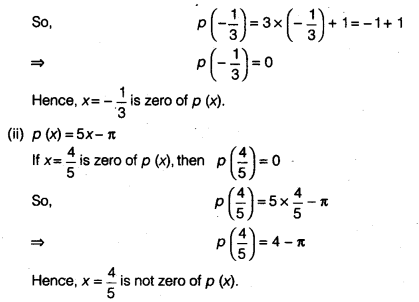
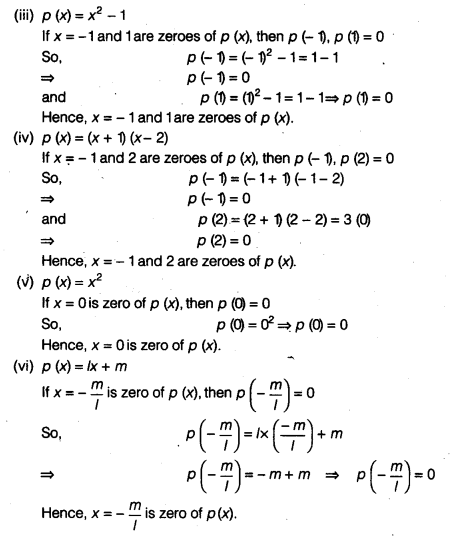
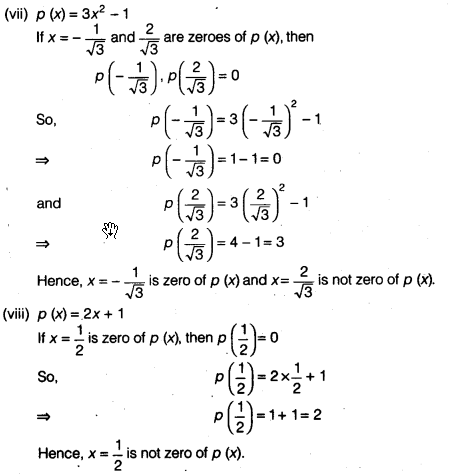
Question 4.
Find the zero of the polynomial in each of the following cases
(i) p(x)=x+5
(ii) p (x) = x – 5
(iii) p (x) = 2x + 5
(iv) p (x) = 3x – 2
(v) p (x) = 3x
(vi) p (x)= ax, a≠0
(vii) p (x) = cx + d, c≠ 0 where c and d are real numbers.
Solution:
(i) We have, p (x)= x+ 5
Now, p (x) = 0
⇒ x+ 5 = 0
⇒ x = -5
∴ – 5 is a zero of the polynomial p (x).
(ii) We have, p (x) = x – 5
Now, p (x) = 0
⇒ x – 5 = 0
⇒ x = 5
∴ 5 is a zero of the polynomial p (x).
(iii) We have, p (x) = 2x + 5
Now, P (x)= 0
⇒ 2x+ 5= 0
⇒ x = –
∴ –
(iv) We have, p (x)= 3x- 2
Now p(x) = 0
⇒ 3x- 2 = 0
⇒ x=
∴
(v) We have, p (x) = 3x
Now, p (x)= 0
⇒ 3x=0
⇒ x =0
∴ 0 is a zero of the polynomial p (x).
(vi) We have, p (x)= ax, a ≠ 0
Now, p (x)= 0 ⇒ ax= 0
⇒ x= 0
∴ 0 is.a zero of the polynomial p (x).
(vii) We have, p (x) = cx + d,c ≠ 0
Now, p (x) = 0
⇒ cx + d = 0
x = –
∴ –
Exercise 2.3
Question 1.
Find the remainder when x3 + 3x2 + 3x + 1 is divided by
(i) x + 1
(ii) x –
(iii) x
(iv) x + π
(v) 5 + 2x
Solution:
Let p (x) = x3 + 3x2 + 3x + 1
(i) The zero of x+ 1 is – 1. (∵ x+ 1 = 0= x = -1)
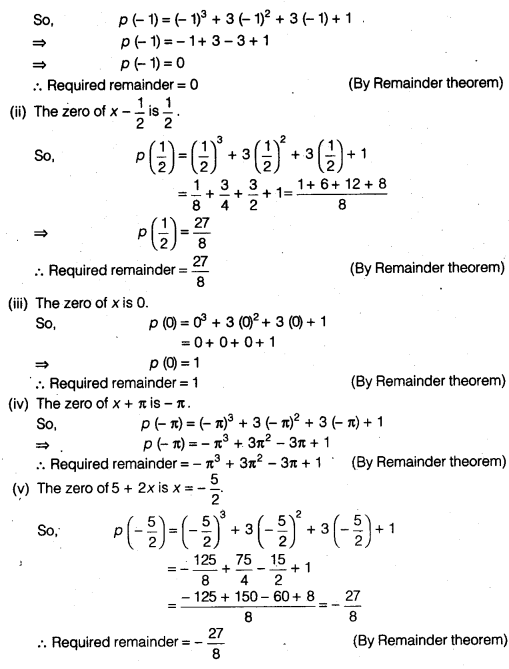
Question 2.
Find the remainder when x3-ax2 +6x-ais divided by x – a.
Solution:
The zero of x – a is a. (∵ x – a = 0 =» x= a)
Let p (x) = x3 – ax2 + 6x – a
So, p (a) = a3 – a (a)2 + 6a – a = a3 – a3 + 5a
⇒ p (a) = 5a
∴ Required remainder = 5a (By Remainder theorem)
Question 3.
Check whether 7 + 3x is a factor of 3x3+7x.
Solution:
Let f(x) = 3x3+7x
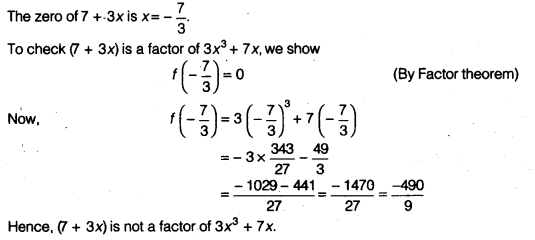
Exercise 2.4
Question 1.
Determine which of the following polynomials has (x +1) a factor.
(i) x3+x2+x +1
(ii) x4 + x3 + x2 + x + 1
(iii) x4 + 3x3 + 3x2 + x + 1
(iv) x3 – x2 – (2 +√2 )x + √2
Solution:
The zero of x + 1 is -1.
(i) Let p (x) = x3 + x2 + x + 1
Then, p (-1) = (-1)3 + (-1)2 + (-1) + 1 .
= -1 + 1 – 1 + 1
⇒ p (- 1) = 0
So, by the Factor theorem (x+ 1) is a factor of x3 + x2 + x + 1.
(ii) Let p (x) = x4 + x3 + x2 + x + 1
Then, P(-1) = (-1)4 + (-1)3 + (-1)2 + (-1)+1
= 1 – 1 + 1 – 1 + 1
⇒ P (-1) = 1
So, by the Factor theorem (x + 1) is not a factor of x4 + x3 + x2 + x+ 1.
(iii) Let p (x) = x4 + 3x3 + 3x2 + x + 1 .
Then, p (-1)= (-1)4 + 3 (-1)3 + 3 (-1)2 + (- 1)+ 1
= 1- 3 + 3 – 1 + 1
⇒ p (-1) = 1
So, by the Factor theorem (x + 1) is not a factor of x4 + 3x3 + 3x2 + x+ 1.
(iv) Let p (x) = x3 – x2 – (2 + √2) x + √2
Then, p (- 1) =(- 1)3- (-1)2 – (2 + √2)(-1) + √2
= -1 – 1+ 2 +√2+√2
= 2√2
So, by the Factor theorem (x + 1) is not a factor of
x3 – x2 – (2 + √2) x + √2.
Question 2.
Use the Factor Theorem to determine whether g (x) is a factor of p (x) in each of the following cases
(i) p (x)= 2x3 + x2 – 2x – 1, g (x) = x + 1
(ii) p(x)= x3 + 3x2 + 3x + X g (x) = x + 2
(iii) p (x) = x3 – 4x2 + x + 6, g (x) = x – 3
Solution:
(i) The zero of g (x) = x + 1 is x= -1.
Then, p (-1) = 2 (-1)3+ (-1)2 – 2 (-1)-1 [∵ p(x) = 2x3 + x2 – 2x -1]
= -2 + 1 + 2 – 1
⇒ P (- 1)= 0
Hence, g (x) is a factor of p (x).
(ii) The zero of g (x) = x + 2 is – 2.
Then, p (- 2) = (- 2)3 + 3 (- 2)2 +3 (- 2) + 1 [∵ p(x) = x3 + 3x2 + 3x + 1]
= – 8 + 12 – 6 + 1
⇒ p(-2) = -1
Hence, g (x) is not a factor of p (x).
(iii) The zero of g (x) = x – 3 is 3.
Then, p (3) = 33 – 4 (3)2+3 + 6 [∵ p(x) = x3-4x2 + x+6]
= 27 – 36+ 3 +6
⇒ p(3) = 0
Hence, g (x) is a factor of p (x).
Question 3.
Find the value of k, if x – 1 is a factor of p (x) in each of the following cases
(i) p (x) = x2 + x + k
(ii) p (x) = 2x2 + kx + √2
(iii) p (x) = kx2 – √2 x + 1
(iv) p (x) = kx2 – 3x + k
Solution:
The zero of x – 1 is 1.
(i) (x – 1) is a factor of p (x),then p(1)= 0 (By Factor theorem)
⇒ 12 + 1 + k = 0 [∵ p(x) = x2 + x + k]
⇒ 2 + k =0
⇒ k = -2
(ii) ∵ (x -1) is a factor of p (x), then p (1) = 0 (By Factor theorem)
⇒ 2(1)2 + k(1)+√2= 0 [∵p(x) = 2x2 + kx+ -√2]
⇒ 2 + k + √2 = 0
⇒ k = – (2 + √2)
(iii) ∵ (x-1) is a factor of p (x), then p (1) = 0 (By Factor theorem)
⇒ k (1)2 – √2 + 1 = 0 [∵p(x) = kx2 – √2x + 1]
⇒ k = (√2 – 1)
(iv) ∵ (x-1) is a factor of p (x), then p (1) = 0 (By Factor theorem)
⇒ k(1)2 – 3 + k = 0 [∵p(x) = kx2 – 3x + k]
⇒ 2k-3 = 0
⇒ k =
Question 4.
Factorise
(i) 12x2 – 7x +1
(ii) 2x2 + 7x + 3
(iii) 6x2 + 5x – 6
(iv) 3x2 – x – 4
Solution:
(i) 12x2 – 7x + 1 = 12x2 – 4x- 3x + 1 (Splitting middle term)
= 4x (3x – -0 -1 (3x-1)
= (3x -1) (4x -1)
(ii)2x2 + 7x + 3 = 2x2 + 6x + x + 3 (Splitting middle term)
= 2x (x + 3) +1 (x + 3) = (x + 3) (2x+ 1)
(iii) 6x2 + 5x – 6= 6x2 + 9x- 4x- 6 (Splitting middle term)
= 3x(2x+3)-2(2x+3)=(2x+3)(3x-2)
(iv) 3x2 – x- 4= 3x2-4x+3x-4 (Splitting middle term)
= x (3x – 4) + 1 (3x – 4)= (3x- 4) (x + 1)
Question 5.
Factorise
(i) x3 – 2x2 – x + 2
(ii) x3 – 3x2 – 9x – 5
(iii) x3 + 13x2 + 32x + 20
(iv) 2y3 + y2 – 2y – 1
Solution:
(i) Let p (x) = x3 – 2x2 – x+ 2, constant term of p (x) is 2.
Factors of 2 are ± 1 and ± 2.
Now, p (1) = 13 – 2 (1)2 – 1 + 2
=1- 2 – 1 + 2
p(1) = 0
By trial, we find that p (1) = 0, so (x – 1) is a factor of p (x).
So, x3 – 2x2 – x+ 2
= x3 – x2 – x2 + x – 2x + 2
= x2 ( x -1)- x (x – 1)-2 (x – 1)
= (x – 1)(x2 – x – 2)
= (x – 1)(x2 – 2x+x-2)
= (x – 1) [x (x – 2) + 1 (x – 2)]
= (x – 1) (x – 2)(x + 1)
(ii) Let p(x) = x3 – 3x2 – 9x – 5
By trial, we find that p(5) = (5)3 – 3(5)2 – 9(5) – 5
=125 – 75 – 45 – 5 = 0
So, (x – 5) is a factor of p(x).
So, x3 – 3x2 – 9x – 5
= x3-5x2 + 2x2-10x+x-5
= x2(x – 5)+2x(x – 5)+1(x – 5)
= (x – 5) (x2 + 2x + 1)
= (x – 5) (x2 + x + x + 1)
= (x – 5) [x (x + 1)+ 1 (x+ 1)]
= (x – 5) (x + 1) (x + 1)
= (x – 5)(x+1)2
(iii) Let p (x) = x3 + 13x2 + 32x + 20
By trial, we find that p (-1) = (-1)3 + 13(-1)2 + 32 (-1) + 20
= -1+13 – 32 + 20 = -33 + 33 = 0
So (x + 1) is a factor of p (x).
So, x3 + 13x2 + 32x + 20
= x3+ x2 + 12x2 + 12x+ 20x+ 20
=x2(x+ 1) + 12x(x+ 1)+ 20 (x+ 1)
= (x+1)(x2+12x+20)
= (x+ 1) (x2+ 10x + 2x+ 20)
= (x+1)[x(x+10)+2(x+10)]
= (x+ 1) (x+ 10) (x + 2)
(iv) Let p (y) = 2y3 + y2 – 2y -1
By trial we find that p(1) = 2 (1)3 + (1)2 – 2(1) – 1 = 2 + 1 – 2 -1 = 0
So (y -1) is a factor of p (y).
So, 2y3 + y2 – 2y -1
= 2y3 – 2y2+ 3y2 – 3y + y – 1
= 2y2(y – 1) + 3y(y – 1)+1(y – 1)
= (y – 1) (2y2 + 3y + 1)
= (y – 1)(2y2 + 2y +y+1)
= (y – 1 [2y (y + 1) + 1 (y + 1)]
= (y – 1)(y+1)(2y+1)
Exercise 2.5
Question 1.
Use suitable identities to find the following products
(i) (x + 4)(x + 10)
(ii) (x+8) (x -10)
(iii) (3x + 4) (3x – 5)
(iv) (y2+
(v) (3 – 2x) (3 + 2x)
Solution:
(i) (x+ 4) (x + 10)
Using identity (iv), i.e., (x+ a) (x+ b) = x2 + (a + b) x+ ab.
We have, (x+4) (x + 10) = x2+(4 + 10) x + (4x 10) (∵ a = 4, b = 10)
= x2 + 14x+40
(ii) (x+ 8) (x -10)
Using identity (iv), i.e., (x + a) (x + b) = x2 + (a + b) x + ab
We have, (x + 8) (x – 10) = x2 + [8 + (-10)] x + (8) (- 10)(∵a = 8, b = -10)
= x2 – 2x – 80
(iii) (3x + 4) (3x – 5)
Using identity Eq. (iv), i.e.,
(x + a) (x + b) = x2 + (a + b) x + ab
We have, (3x + 4) (3x – 5) = (3x)2 + (4 – 5) x + (4) (- 5) (∵a = 4, b = -5)
= 9x2 – x – 20
Question 2.
Evaluate the following products without multiplying directly
(i) 103 x 107
(ii) 95 x 96
(iii) 104 x 96
Solution:
(i) 103 x 107 = (100 + 3) (100 + 7)
= 100 x 100+ (3 + 7) (100)+ (3 x 7) [Using identity (iv)]
= 10000+ 1000+21 = 11021
(ii) 95 x 96 = (100-5) (100-4)
= 100 x 100 + [(- 5) + (- 4)] 100 + (- 5 x – 4) [Using identity (iv)]
= 10000 – 900 + 20 = 9120
(iii) 104 x 96 = (100 + 4) (100 – 4)
= (100)2-42 [Using identity (iii)]
= 10000-16 = 9984
Question 3.
Factorise the following using appropriate identities
(i) 9x2+6xy+ y2
(ii) 4y2-4y + 1
(iii) x2 –
Solution:

Question 4.
Expand each of the following, using suitable identity
(i) (x+2y+ 4z)2
(ii) (2x – y + z)2
(iii) (- 2x + 3y + 2z)2
(iv) (3a -7b – c)z
(v) (- 2x + 5y – 3z)2
(vi) (
Solution:
(i) (x + 2y + 4z)2 = x2 + (2y)2 + (4z)2 + 2 (x) (2y) + 2 (2y) (4z) + 2(4z) (x) [Using identity (v)]
= x2 + 4y2 + 16z2 + 4xy + 16yz + 8 zx
(ii) (2x – y + z)2 = (2x)2 + (- y)2 + z2 + 2 (2x) (- y)+ 2 (- y) (z) + 2 (z) (2x) [Using identity (v)]
= 4x2 + y2 + z2 – 4xy – 2yz + 4zx
(iii) (- 2x + 3y + 2z)2 = (- 2x)2 + (3y)2 + (2z)2 + 2 (- 2x) (3y)+ 2 (3y) (2z) + 2 (2z) (- 2x) [Using identity (v)]
= 4x2 + 9y2 + 4z2 – 12xy + 12yz – 8zx
(iv) (3a -7b- c)2 = (3a)2 + (- 7b)2 + (- c)2 + 2 (3a) (- 7b) + 2 (- 7b) (- c) + 2 (- c) (3a) [Using identity (v)]
= 9a2 + 49b2 + c2 – 42ab + 14bc – 6ac
(v) (- 2x + 5y- 3z)2 = (- 2x)2 + (5y)2 + (- 3z)2 + 2 (- 2x) (5y) + 2 (5y) (- 3z) + 2 (- 3z) (- 2x) [Using identity (v)]
= 4x2 + 25y2 + 9z2 – 20xy – 30yz + 12zx

Question 5.
Factorise
(i) 4 x2 + 9y2 + 16z2 + 12xy – 24yz – 16xz
(ii) 2x2 + y2 + 8z2 – 2√2xy + 4√2yz – 8xz
Solution:
(i) 4x2 + 9y2 + 16z2 +12xy-24yz-16xz
= (2x)2 + (3y)2 + (- 4z)2 + 2 (2x) (3y) + 2 (3y) (- 4z) + 2 (- 4z) (2x)
= (2x + 3y – 4z)2
(ii) 2x2 + y2 + 8z2 – 2√2xy + 4√2yz – 8xz
= (- √2x)2 + (y)2 + (2 √2z)2 + 2(- √2x) (y)+ 2 (y) (2√2z) + 2 (2√2z) (- √2x)
= (- √2x + y + 2 √2z)2
Question 6.
Write the following cubes in expanded form

Solution:
(i) (2x + 1)3 = (2x)3 + 13 + 3 (2x) (1) (2x + 1) [Using identity (x + y)3 = x3 + y3 + 3xy (x + y)]
= 8x3 + 1 + 6x (2x + 1)
= 8x3 + 1 + 12x2 + 6x= 8x3 + 12x2 + 6x + 1
(ii) (2a – 3b)3 = (2a)3 – (3b)3 -3(2a)(3b)(2a-3b) [Using identity (x-y)3=x3-y3 -3xy(x-y)]
= 8a3-27b3-18ab(2a-3b)
= 8a3 – 27 b3 – 36a2b + 54ab2
=8a3 – 36a2b + 54ab2 – 27 b3


Question 7.
Evaluate the following using suitable identities
(i) (99)3
(ii) (102)3
(iii) (998)3
Solution:
(i) (99)3 =(100-1)3 = 1003 -(1)3 – 3x 100x 1(100-1) [Using identity (x-y)3 =x3-y3-3xy (x-y)]
=1000000-1-300(100-1)
=1000000-1-30000+300
=970299
(ii) (102)3 = (100+ 2)3 = 1003 + 23 + 3x 100x 2 (100+ 2 [Using identity (x + y)3 = x3 + y3 + 3xy (x + y)]
=1000000 + 8 + 600(100+ 2)
=1000000 + 8 + 60000+ 1200=1061208
(iii) (998)3 = (1000-2)3 =10003 – 23 – 3x 1000x 2(1000-2) [Using identity (x-y)3=x3-y3-3xy (x-y)]
=1000000000-8-6000(1000-2)
= 1000000000- 8 – 6000000+12000
=994011992
Question 8.
Factorise each of the following
(i) 8a3 +b3 + 12a2b+6ab2
(ii) 8a3 -b3-12a2b+6ab2
(iii) 27-125a3 -135a+225a2
(iv) 64a3 -27b3 -144a2b + 108ab2
![]()
Solution:
(i) 8a3 +b3 +12a2b+6ab2 = (2a)3 + b3 + 3x 2axb (2a+ b)
=(2a+b)3 [Using identity (vi)]
(ii) 8a3 -b3 -12a2b+ 6ab2 = (2a)3 + (-b)3 + 3x2ax (-b)[(2a)+ (-b)]
= (2a)3 – (b)3 – 3 x 2ax b (2a-b) [Using identity (vii)]
=(2 a-b)3
(iii) 27-125a3-135a + 225a2 =(3)3 + (-5a)3 + 3x3x(-5a)[(3)+(-5a)]
= (3)3 -(5a)3– 3x3x5a(3-5a) [Using identity (vii)]
= (3=5 a)3
(iv) 64a3 – 27b3 -144a2b +108ab2 =(4a)3 + (-3b)3 + 3x4ax(-3b)[4a+ (-3b)]
=(4a)3-(3b)3-3x4ax3b(4a-3b)
=(4a-3b)3 [Using identity (vii)]

Question 9.
Verify
(i) x3 + y3 = (x + y)-(x2 – xy + y2)
(ii) x3 – y3 = (x – y) (x2 + xy + y2)
Solution:
(i) We know that,
(x + y)3 = x3 + y3 + 3xy (x + y)
⇒ x3 + y3 = (x + y)3 – 3xy (x + y)
= (x + y) [(x + y)2 – 3xy]
= (x + y) [x2 + y2 + 2xy – 3xy]
= (x + y) [x2 + y2 – xy]
= RHS
Hence proved,
(ii) We .know that,
(x – y)3 = x3 – y3 – 3xy (x – y) x3 – y3
= (x – y)3 + 3xy (x – y)
= (x – y) [(x – y)2 + 3xy]
= (x – y) [x2 + y2 + 2xy + 3xy]
= (x – y) [x2 + y2 + xy]
= RHS
Hence proved.
Question 10.
Factorise each of the following
(i) 27y3 + 125z
(ii) 64rh3 – 343n [Hint See question 9]
Solution:
(i) 27y3 + 125z3 = (3y)3 + (5z)3
= (3y + 5z) [(3y)2 – (3y) (5z) + (5z)2]
= (3y + 5z) (9y2 – 15yz + 25z2)
(ii) 64 m3 – 343 n3 = (4m)3 – (7n)3
= (4m – 7n) [(4m)2 + (4m) (7n) + (7n)2]
= (4m – 7 n) [16m2 + 28mn + 49n2]
Question 11.
Factorise 27x3 +y3 +z3 -9xyz.
Solution:
27x3 + y3 + z3-9xyz=(3x)3 + y3 + z3 -3x 3xx yx z
=(3x+y+z)[(3x)2 + y2 + z2– 3xy – yz -z(3x)][Using identity (viii)]
=(3x+ y + z) (9x2 + y2 + z2 -3xy -yz -3zx)
Question 12.
Verify that
x3 +y3 +z3 -3xyz =
Solution:
x3 + y3 + z3-3xyz = (x+y+z)[x2 + y2 + z2-xy-yz-zx]
=
=
=
=
Question 13.
If x + y + z = 0, show that x3 + y3 + z3 = 3 xyz.
Solution:
We know that,
x3 + y3 + z3 – 3 xyz = (x + y + z) (x2 + y2 + z2 – xy – yz – zx [Using identity (viii)]
= 0(x2 + y2 + z2 – xy – yz – zx) (∵ x + y + z = 0 given)
= 0
⇒ x3 + y3 + z3 = 3 xyz
Hence proved.
Question 14.
Without actually calculating the cubes, find the value of each of the following
(i) (- 12)3 + (7)3 + (5)3
(ii) (28)3 + (- 15)3 + (- 13)3
Solution:
We know that, x3 + y3 + z3 -3xyz
=(x+y+z)(x2 + y2 + z2 – xy – yz – zx)
If x+y+z=0, then x3 + y3 + z3-3xyz=0
or x3 + y3 + z3 = 3xyz
(i) We have to find the value of (-12)3 + (7)3 + (5)3
Here, -12+7+5=0
So, (-12)3 + (7)3 + (5)3= 3x(-12)(7)(5)
=-1260
(ii) We have to find the value of (28)3 + (-15)3 + (-13)3.
Here, 28+(-15)+(-13)=28-15-13 =0
So, (28)3 + (-15)3 + (-13)3
= 3x (28) (-15) (-13)
= 16380
Question 15.
Give possible expressions for the length and breadth of each of the following rectangles, in which their areas are given
(i) Area 25a2 – 35a + 12
(ii) Area 35y2 + 13y – 12
Solution:
(i) We have, area of rectangle
= 25a2 – 35a+12
= 25a2 – 20a – 15a+12
= 5a(5a – 4)-3(5a – 4)=(a-4)(5a – 3)
Possible expression for length =5a-3
and breadth =5a-4
(ii) We have, Area of rectangle = 35y2+13y – 12=35y2 -15y + 28y – 12
=5y(7y – 3)+4(7y – 3) = (7y – 3)(5y+4)
Possible expression on for length =7y-3
and breadth =5y+4
Question 16.
What are the possible expressions for the dimensions of the cuboids whose volumes are given below?
(i) Volume 3x2 – 12x
(ii) Volume 12ky2 + 8ky – 20k
Solution:
(i) We have, volume of cuboid =3x2-12x=3x(x – 4)
One possible expressions for the dimensions of the cuboid is 3, x and x-4.
(ii) We have, volume of cuboid =12ky2 + 8ky-20k
=12ky2 + 20ky-12ky-20k
=4ky (3y+5) – 4k(3y+5)
=(3y+5)(4ky – 4k)
=(3y+5)4k(y – 1)
One possible expressions for the dimensions of the cuboid is 4k, 3y+5 and y – 1.